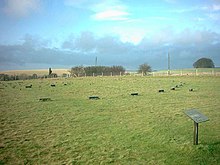The Sanctuary
Coordinates: 51 ° 24 ′ 40 " N , 1 ° 49 ′ 53" W.
The Sanctuary is a to about 3000 BC. Neolithic cult site near the Avebury Henge, dated to BC . Today The Sanctuary is on the A4 (country road) between Avebury and Silbury Hill . The cult site was first mentioned in writing in 1668 by Samuel Pepys . This associated The Sanctuary with Stonehenge , but it is actually part of the cult complex around Avebury. The UNESCO declared Stonehenge, Avebury and Associated Sites , including The Sanctuary heard 1986 World Heritage Site .
Today the place of worship has been completely destroyed and only concrete markings still show the positions where stones and wooden posts were once located. The sarsen stones and wooden posts were arranged in seven concentric circles. The outermost circle is roughly the diameter of the Stonehenge stone circle. The stones are estimated to be around 1.5 m high. The height of the wooden piles is unknown and it has not been established whether they stood free or were part of a construction. The stones were used as building material and the positions of the wooden piles were not determined until excavations in the 1930s. The destruction of the structure in 1723 was so lasting that Maud Cunnington had to search extensively for the cult site in the 1930s before the excavations could begin.
Etchings from the 16th century show that The Sanctuary was connected to West Kennet Avenue , the stone avenue running towards West Kennet Long Barrow .
Today science suggests that The Sanctuary was a burial site, as an unusually large number of human remains were found on the site. It is believed that the dead were put to the gang in The Sanctuary and later some of the bones were taken back home as part of a death cult. Some of the bones show traces of fire, so it is assumed that cremations were also carried out at times.
The antiquarian William Stukeley describes The Sanctuary as the head of the stone serpent he claims to have discovered in Avebury and the surrounding stone avenues. Today this is viewed as a misinterpretation, as Stukeley got lost in the druid theory in his later work and his interpretations are not considered serious. W. Stuckeley made some drawings and maps of the layout, on which the positions of the stones are noted.
literature
- Esther Smith: Avebury Avenues - the way to discover the stone circles, second edition 2005 . Forward Publications, ISBN 0-9544916-0-2
